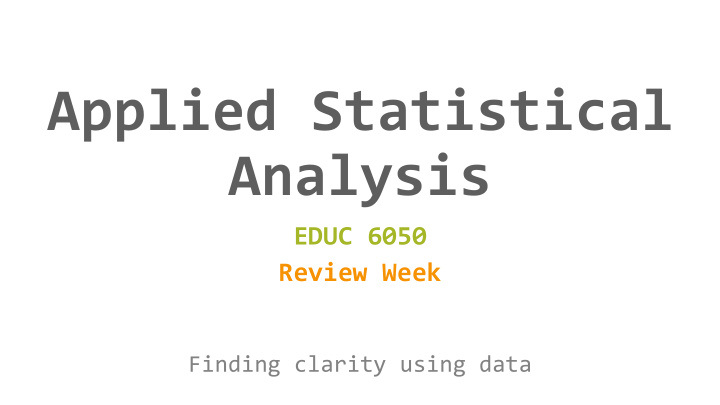



Applied Statistical Analysis EDUC 6050 Review Week Finding clarity using data
Today Connect the Methods 2
Selecting the Right Method 3
Selecting Method Based on Research Question Does research question have to do with looking at differences among groups or relationships among continuous variables? Z-tests T-tests Correlation ANOVAs Regression Chi Square Regression 4
Z-tests compare our sample to known values ANOVAs compare: t-tests compare: 1) 3+ independent 1) Our sample to Z-tests samples (groups) known values T-tests 2) 3+ repeated samples 2) Two independent ANOVAs (time points) samples (groups) Chi Square 3) Both groups and 3) Two paired-samples Regression repeated samples at (time points) the same time Regression compares: Chi Squares compare: 1) 1+ categorical variable(s) 1) 1 categorical variable to 2) Controls for the effects of known values the covariates 2) 2 categorical variables 3) Can also do a lot more... 5
Z-tests compare our sample to known values ANOVAs compare: t-tests compare: All but Chi Square 1) 3+ independent 1) Our sample to Z-tests samples (groups) known values T-tests 2) 3+ repeated samples has a continuous 2) Two independent ANOVAs (time points) samples (groups) Chi Square 3) Both groups and 3) Two paired-samples Regression repeated samples at outcome (time points) the same time Regression compares: Chi Squares compare: 1) 1+ categorical variable(s) 1) 1 categorical variable to 2) Controls for the effects of known values the covariates 2) 2 categorical variables 3) Can also do a lot more... 6
Correlation tells us the direction and magnitude of a relationship between two continuous variables Correlation Regression Regression tells us the direction and magnitude (in the units of the outcome) of a relationship between two continuous variables (Can also have categorical variables in the model at the same time) 7
Correlation tells us the direction and magnitude of a relationship between two continuous variables Continuous outcomes Correlation Regression Regression tells us the direction and magnitude (in the units of the outcome) of a relationship between two continuous variables (Can also have categorical variables in the model at the same time) 8
Selecting Method Based on Available Data - Outcome Is your outcome variable continuous (interval/ratio) or categorical (ordinal, nominal)? Z-tests T-tests Logistic Regression ANOVAs Chi Square Regression 9
Selecting Method Based on Available Data - IV Is your independent variable(s) continuous (interval/ratio) or categorical (ordinal, nominal)? Z-Tests T-Tests Regression ANOVAs Logistic Regression Chi Square Regression Logistic Regression 10
Question 1 We hypothesize that test scores are caused by amount of time studying and note-taking style. What approach could we use? 11
Question 2 We investigate the question of whether preferences for money/flying are different across degree types. What approach could we use? 12
Question 3 We want to know the relationship between poverty level (continuous) and teen birth rate (continuous). What approach could we use? 13
Question 4 We want to know if our intervention regarding adult mobility works. We have two groups (intervention and control) and test both groups at pretest and posttest. What approach could we use? 14
Interpreting the Results 15
Common Threads Across Methods 1.Test Statistic 2.P-Value 3.Effect Size 16
Common Threads Across Methods 1.Test Statistic 2.P-Value 3.Effect Size
Common Threads Across Methods 1.Test Statistic 2.P-Value 3.Effect Size 18
Unique Things The Estimate Model Comparisons 19
Question 5 Interpret the following output 20
Question 6 Interpret the following output 21
Question 7.1 Interpret the following output 22
Question 7.2 Interpret the following output 23
Next week: Final Exam :) 24
Recommend
More recommend